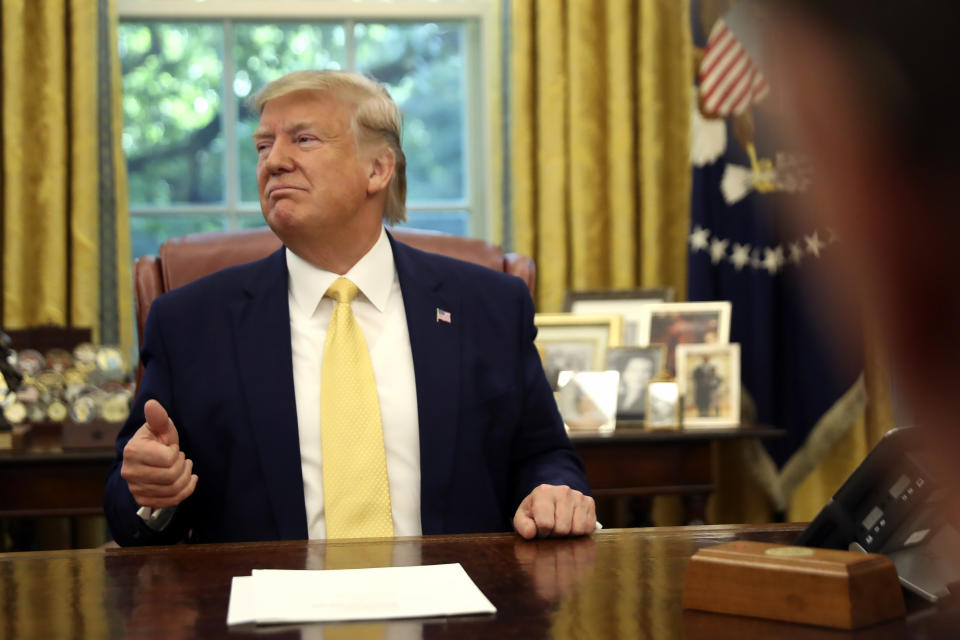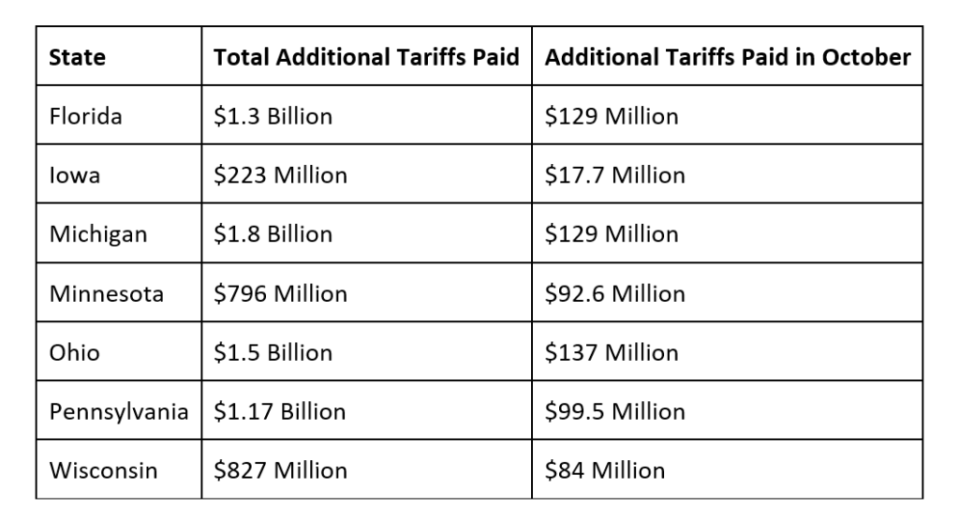Trade war: New analysis updates staggering amount Americans pay for Trump's tariffs
As the U.S. and China continue negotiations over a trade deal, the damage continues across many areas of the country.
Since the trade war commenced in February 2018, Americans have paid an additional $42 billion, according to a new analysis from Tariffs Hurt the Heartland (THH). And just in October 2019, the trade war cost Americans $7.2 billion through tariffs, which is a $1 billion increase from October 2018.
“According to an analysis of data from the president’s own Department of Commerce, American businesses, farmers, and consumers — and not China — have paid $42 billion in additional taxes because of these tariffs,” Americans for Free Trade spokesperson Jonathan Gold said in a statement.
He continued: “This trade war has lasted long enough and done enough damage. It’s time the administration finalize a deal with China to end the trade war and remove all tariffs.”

The two sides are still working towards a deal. If none is reached by Dec. 15, then President Trump will increase tariffs on $165 billion of Chinese goods.
“It should be clear now if it wasn’t a year ago that nobody wins a trade war,” Doug Barry, senior director of communications and publications for the U.S.-China Business Bureau (USCBC), told Yahoo Finance. “The losers in the U.S. are farmers, ranchers, import and export businesses, and consumers. To the extent that U.S. government policies have created the perception of an unwelcoming atmosphere here for foreign tourists, students, and investment from countries, we’ve expanded the number of our own feet that we’re shooting.”
Farmers ‘are paying a steep price’
Tariffs were first levied on all steel imports, with some exceptions, at a rate of 25% on March 23, 2018. Aluminum imports were slapped with a 10% tariff. From there, it became a game of tit-for-tat between the U.S. and China. American agriculture was hit particularly hard by retaliatory Chinese tariffs and hasn’t fully recovered since.
“This data shows that farmers in America’s heartland — the very places where the 2020 campaign will turn — are paying a steep price because of the trade war,” Farmers for Free Trade Co-Executive Director Brian Kuehl stated. “The president needs to show he can close not just a phase one deal, but a comprehensive deal that rolls back the tariffs and ends the trade war. Farmers want long-term reliable markets. One-time purchases are not a replacement for the certainty that global trade opportunities provide.”

The data found that residents in seven of the top swing states have paid $7.7 billion in taxes as a result of the tariffs, with Michigan being the highest at $1.8 billion. In Michigan and in Wisconsin, unemployment is on the rise, “with Moody’s Analytics estimating the trade war has reduced U.S. employment by 300,000,” according to THH. Manufacturing contracted for the fourth month in a row in November 2019 as well.
‘It’s time to junk punitive tariffs’
According to the USCBC’s 2019 State Export Report, the U.S. saw a 7% decline in goods exported to China between 2017-2018. And 36 states exported fewer goods to China in 2018 than they did in 2017. This is likely tied to the tariffs spurred by the trade war.
Barry predicted that things could get even worse heading into 2020 if the U.S. applies more retaliatory tariffs on China on Dec. 15.
“China has announced that its government departments will switch out U.S.-made IT hardware and software with homegrown replacements,” he said. “Very bad news for U.S. IT supplies and their workers here in the U.S. China is also taking aim at its feet with this move.”

The key is for there to be less talk and more action, according to Barry, particularly with a locked-down phase one trade agreement between the two countries.
“We need a phase one agreement now, with a path to additional negotiations on a raft of disagreements,” Barry said. “China needs to play by international rules, and it’s right to press them to do so. But trade wars produce losers, not winners. And it’s time to junk punitive tariffs.”
Adriana is an associate editor for Yahoo Finance. She can be reached at adriana@yahoofinance.com. Follow her on Twitter @adrianambells.
READ MORE:
'Losing two farms a day': Wisconsin is facing a serious dairy crisis
Buttigieg on Trump’s trade war: This is bigger than ‘who’s selling more dishwashers’
Trade war damage is 'more significant than most Americans ever realized'
Read the latest financial and business news from Yahoo Finance
Follow Yahoo Finance on Twitter, Facebook, Instagram, Flipboard, SmartNews, LinkedIn, YouTube, and reddit.


